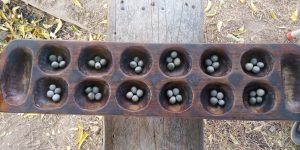Richard Elesho
For regular travellers in the vast Yoruba countryside of Western Nigeria, it is not unusual to randomly find clusters of men, some seated while others stand round a bench, in the cool of the day. The sort of hour God preferred, to check on Adam and Eve in the garden of Eden, as recorded in the Pentateuch, Gen 3: 8.
On the bench will be seated two men, facing one another and wearing serious mien. They habour between them a wooden board, infested with holes, containing several round seeds, which the two take turn to share in an indefinite pattern. One of the men may have a number of pebbles placed in his front. The by-standers watch intently and often run free comments.
To a novice, the group may cut the appearance of characters who are into some levels of voodoo practice or naked paganism. Truth is, they are not involved in any spiritual, let alone mystical exercise. They are gladiators and spectators in a game of wits, called Ayo. Pure and simple.
A game that unites
Ayo has no age, class or gender barriers. Both young and old, rich and poor, learned and unlearned, male and female enjoy it’s fun, although with different levels of caution. Bankers, Professors, skilled and unskilled workers, students are all united in its temple. Former Nigerian President Olusegun Obasanjo is among prominent and avid players of the game.
This game can be addictive. Not a few patrons, made up of both players and spectators find it difficult to extricate from its grip. These people prioritise their favourite game. Often, people therefore choose Idi Ayo, (Ayo spot) as rendezvous for serious discussions, business meetings and other social engagements.
It can be played indoor or outdoor. So long as visibility is not impaired, it can take place anytime and anywhere- under the shade of a tree, tent or house. Primarily conceived for two players, it is one of the best games ever invented by man. Many times, overzealous spectators get carried away to metamorphose into unintended players. Welcome to Ayo, an ancient game of strategy and numbers.
A game of Ayo
A typical Ayo board is carved on wood and easily movable. It is divided down the middle and sometimes collapsible. It contains twelve primary holes, six on each side, facing each other. There are two secondary holes, one to the extreme left and the other to the extreme right. The secondary holes are optional. Children eager to learn, mimick a board, by digging holes in the ground, where they play the game.
Each of the primary holes contains small, round and stone like objects, called seeds. There are four seeds in each hole, 24 on each side of the divide and 48 altogether. The lane or divide nearer to a player is considered as his territory.

A game starts when a player carries the four seeds in any hole in his territory and moves anticlockwise, towards his opponent’s territory, dropping a seed in every hole along it’s path, till his hand is empty. As a rule, a player must always skip the cup or hole from where he packed the seeds. His opponent does the same. It’s an orderly endeavor played one after the other.
The aim of the game is for a player to capture seeds in the opponent’s territory. The player who captures above 24 seeds is the winner.
Seeds are captured when a player sows or shares seeds that end in a house containing at least a seed, but not more than two. In other words, if the seed-movement terminates in a hole with two or three Ayo seeds, this player picks up the seeds, and seeds from preceding holes, if any. His right to capture stops in a house containing a single seed.
Ayo tasks the brain, involving enormous calculation and planning. Deceit and speed are valued attributes of a good player. To enhance victory he may make an Odu – Mother House, where he stores several seeds, for a future bountiful harvest in the enemy territory.
The business of capturing or chopping of seeds must be done in strict adherence to the rules and conditions. One vital rule is that a player cannot and must never eat or capture seeds in a manner that leaves his opponent with no seeds to play. Closely related to the first is that eating is not a matter of choice. Once a movement terminates in two or three, as enumerated above i.e a player cannot eat or capture seeds and refuse to pack them!
If either of the above occurs, it makes the game to end in sudden death, otherwise called lu. It is a foul against the offending player, and though he may have captured more seeds, he is considered worse than an infidel. For asphyxiating his opponent in such a fatal manner, he has lost the game.
A game sleeps (hun) – ends in a draw or a stalemate, when each of the players is able to retain his territory by capturing 24 seeds. A little explanation on how to determine the winner in an Ayo encounter.
Counting in Ayo game
Three games make a set. A player becomes an Ota, a guru when he records three straight wins. For each win a pebble is dropped in front of the Ope, novice or amateur to show his apparent inferior skills. The defeats and counting may continue till nine, if other players are not on line.
If the underdog manages to win any game after his defeat of three and before a humiliating nine, he automatically cuts, as his single victory erases his shame and the pebbles are removed. It is however not possible to ya or cut in nine, which is a permanent scar, without remedy. When there are many players on standby, the looser excuses himself at three, to allow another player face the champion.
Over the years, ayo has become money spinner for the player. Although not yet close to other income earning games, ayo competitions are gradually taking shape locally and internationally.
Origen
The origen of ayo is not known. In fact, it is subject to debate. What one can say with certainty is its roots in antiquity and spread among different cultures in Africa, America, Europe and Asia. Ayo is one of the oldest games in the world. Historians hold its age to be between 3,000 to 7,000 years.
This ancient board game is known in many cultures by different names with slight variations in rules of playing. In parts of northern Nigeria it is Ise, Iche, in Ghana they call it Oware; it corresponds to the Mancala in Australia and United States of America, USA; Awale in English, Caribbean Island; Ouri in Cape Verde; Omweso in Uganda; Igisoro in Rwanda; Hus in South Africa; Gabata in Ethiopia; Poo in Liberia and Layli Goobalay in Somalia just to mention a few.
Each culture has its myth about origin of the game. The most popular account is the one among the Akan people of Ghana. Indeed, Oware is an Akan word meaning “he/ she marries.” Legend has it that the game derived it’s name from a man and a woman who played it endlessly and, so as to be able to stay together and continue playing, they decided to get married.
This account is corroborated by the “marriage theme” which has survived the ages in the game. Even among players till today, the champion or better player is referred to as the husband, while the weaker is the wife.
-Fun and fun all the way
Ayo is a big source of entertainment to the patrons. A player may be boastful about his skills and accompany his moves with verbal gusto that border on panegyric. His expressions may be in praise of self, the board or the spectators.
Reflecting traditional African values, players of Ayo may encourage participation by onlookers, making it perhaps the most social two-player abstract. In recreational play, it is normal for spectators to discuss the game in progress and to advise the players. This is not allowed in a competition.
Games may provide healthy ground to exchange banters and light jokes. Fighting and insults are not tolerated and punishable by a fine, suspension or both. The game, or variations of it, also have an important role in learning arithmetic and tolerance values.
Bored? You may locate the idi ayo nearest to you. Enjoy your day.
Credit: TheNews



